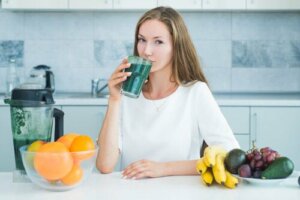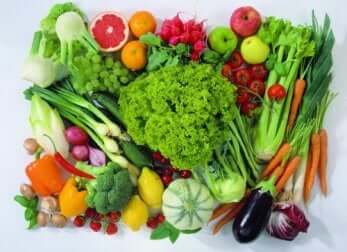9 Natural Ways to Cleanse the Body

The detox trend is on the rise and you’re probably wondering if there are natural ways to efficiently cleanse your body. You don’t want to follow elaborate plans nor harmful methods.
Some of these are simpler than others. However, the truth is that several of them can help you adopt a healthier lifestyle.
Below, we’ll tell you more about this topic and, of course, some natural ways to cleanse your body.
Should you detox your body?
While it’s clear that the main goal of a detox is to enjoy good health, this may sound so general that some people overlook its other benefits.
By detoxifying your body, you can improve your health but also your mood and energy levels. Your hair, skin, and nails will reflect the changes and, as a result, you’ll look and feel better. In short, you’ll be more comfortable both inside and out.
If you manage to maintain good life habits over time, you’ll enjoy a good quality of life and well-being. Thus, always try to keep in mind the benefits you’ll enjoy so you’ll do it consistently.
Find out Everything You Need to Know About Liver Detox Diets
Natural ways to cleanse your body
The human body has its own systems to eliminate possible toxins that may accumulate. These are the lungs, kidneys, liver and skin.
So all those practices that help to keep these organs healthy, are the most appropriate to carry out a detoxification in a natural way.
1. Stay hydrated

Of course, to detoxify your body naturally, experts also recommended making sure that you drink enough water daily.
You don’t need to drink one or two and a half quarts of water every day. You should drink depending on your thirst and your needs.
Remember that each person’s water consumption depends on several factors, such as:
- Sex
- Age
- The state of health
- The physical activity you do on a daily basis and, in general, your lifestyle
Note: If you want to know more about some properties of water and aqueous solutions, the factors that influence body water content and other related aspects, you can consult the following document from the Spanish Nutrition Foundation (FEN).
2. Eat fresh foods

Base your diet on raw fruits and vegetables. They provide vitamins, minerals, fiber, enzymes, and antioxidants. They’re also good for stimulating cellular regeneration and removing toxins from your blood.
Choosing healthy, fresh, and naturally sourced foods will contribute a lot to your health and well-being in general and will also help you maintain a healthy weight.
Experts also recommend incorporating more whole grains than refined flours in your diet. Other recommended options that you can enjoy are millet, quinoa, buckwheat, and oats.
3. Eliminate fried foods, refined sugars, and flours from your diet
You should avoid industrial foods, ultra-processed foods, frozen foods, fried foods, sweets, snacks, industrial drinks (including juices, teas, and flavored waters), as well as coffee, alcohol, and tobacco.
Today, the “real fooding” movement is inspiring people who want to start improving their eating habits and making better decisions in their daily lives.
4. Opt for natural drinks instead of industrial ones
Instead of consuming soft drinks, flavored beverages such as teas, juices, and other industrial junk food, try to include natural homemade drinks without added sugar or sweeteners in your diet.
Some of the options you can choose from are fruit juices, smoothies, shakes, teas, and infusions. Take advantage of a dandelion, mint, chamomile, and green tea infusion!
5. Exercise daily

To detoxify your body naturally, you also need to move your body and stay active day by day. Thus, avoid leading a abandon a sedentary lifestyle. Find an activity you like and start doing it.
As you get in the habit of exercising daily for at least 30 minutes, you can incorporate various other practices.
This means that, in addition to walking 30 minutes a day, you can do some cardiovascular exercises at home or complement your routine with a sport or a fun activity such as zumba.
Regular exercise has a positive effect on reducing stress and the inflammatory state of the body. As a result of these actions, it can prevent the onset of some chronic diseases and metabolic disorders as well as improve mood and well-being.
6. One of the natural ways to preserve your health is to brush your body
It’s said that brushing your skin gently after a soothing bath can help to remove dead cells, dirt, and, at the same time, reactivate blood flow. This can also stimulate the lymphatic system.
Brush your body occasionally with a brush with soft, preferably natural, bristles and give your skin extra pampering.
Read about 5 Ways to Use Lavender for Relaxing
7. De-stress!
Remember that it’s also important for you to take care of your mental health. To do this, you don’t need to look for a specific method. You just have to learn to dedicate some time, practice the activities that you like the most, or that attract your attention and, thus, release tension.
Dancing, listening to music, playing an instrument, painting, doing crafts, meditating, writing a poem, watching an episode of your favorite TV show, and eating a homemade dessert can help you experience pleasure and relax.
Remember that you have to make time for recreation, enjoyment, and relaxation.
8. Get enough sleep is one of the best natural ways to be healthy
Getting a good night’s sleep every day is also a very simple way to stay health. Thus, do your best to get about seven hours of sleep every day.
9. Reduce your use of fragranced products
Scented candles, air fresheners, detergents, and cleaners with artificial fragrances, as well as many cosmetics, have artificial fragrances that can overload the environment.
Studies show that the toxicants contained in these products (phthalates, phenols, flame retardants or perfluorinated substances) are concentrated in dust and indoor air in homes. And they are directly associated with adverse health effects such as reproductive or endocrine toxicity.
Try to moderate their use a bit and avoid placing so many fragranced items in the same space. Likewise, we recommend ventilating your home daily and, above all, the room where you sleep, for at least 10-15 minutes.
Put all these tips into practice and get ready to enjoy better health.
All cited sources were thoroughly reviewed by our team to ensure their quality, reliability, currency, and validity. The bibliography of this article was considered reliable and of academic or scientific accuracy.
- Adams, J., Hofman, K., Moubarac, J.-C., & Thow, A. M. (2020). Public health response to ultra-processed food and drinks. BMJ (Clinical Research Ed.), 369, m2391. https://www.bmj.com/content/369/bmj.m2391
- Bjørklund, G., Cruz-Martins, N., Goh, B. H., Mykhailenko, O., Lysiuk, R., Shanaida, M., Lenchyk, L., Upyr, T., Rusu, M. E., Pryshlyak, A., Shanaida, V., & Chirumbolo, S. (2023). Medicinal Plant-Derived Phytochemicals in Detoxification. Current pharmaceutical design. https://pubmed.ncbi.nlm.nih.gov/37559241/
- Clem, J., & Barthel, B. (2021). A Look at Plant-Based Diets. Missouri medicine, 118(3), 233–238. https://www.ncbi.nlm.nih.gov/pmc/articles/PMC8210981/
- Cordova, R., Viallon, V., Fontvieille, E., Peruchet-Noray, L., Jansana, A., Wagner, K.-H., Kyrø, C., Tjønneland, A., Katzke, V., Bajracharya, R., Schulze, M. B., Masala, G., Sieri, S., Panico, S., Ricceri, F., Tumino, R., Boer, J. M. A., Verschuren, W. M. M., van der Schouw, Y. T., … Freisling, H. (2023). Consumption of ultra-processed foods and risk of multimorbidity of cancer and cardiometabolic diseases: a multinational cohort study. The Lancet Regional Health. Europe, 35(100771), 100771. https://www.thelancet.com/journals/lanepe/article/PIIS2666-7762(23)00190-4/fulltext
- Davani-Davari, D., Negahdaripour, M., Karimzadeh, I., Seifan, M., Mohkam, M., Masoumi, S. J., Berenjian, A., & Ghasemi, Y. (2019). Prebiotics: Definition, Types, Sources, Mechanisms, and Clinical Applications. Foods (Basel, Switzerland), 8(3), 92. https://www.ncbi.nlm.nih.gov/pmc/articles/PMC6463098/
- “Detoxes” and “Cleanses”: What You Need To Know. (s. f.). NCCIH. Consultado el 7 de mayo de 2024. https://www.nccih.nih.gov/health/detoxes-and-cleanses-what-you-need-to-know
- Dunagan, S. C., Dodson, R. E., Rudel, R. A., & Brody, J. G. (2011). Toxics Use Reduction in the Home: Lessons Learned from Household Exposure Studies. Journal of cleaner production, 19(5), 438–444. https://www.ncbi.nlm.nih.gov/pmc/articles/PMC3079220/
- Jiang-Xie, L.-F., Drieu, A., Bhasiin, K., Quintero, D., Smirnov, I., & Kipnis, J. (2024). Neuronal dynamics direct cerebrospinal fluid perfusion and brain clearance. Nature, 627(8002), 157–164. https://www.nature.com/articles/s41586-024-07108-6
- Kondo, R., & Iwakiri, Y. (2020). The lymphatic system in alcohol-associated liver disease. Clinical and molecular hepatology, 26(4), 633–638. https://www.ncbi.nlm.nih.gov/pmc/articles/PMC7641555/
- Latif, A., Shehzad, A., Niazi, S., Zahid, A., Ashraf, W., Iqbal, M. W., Rehman, A., Riaz, T., Aadil, R. M., Khan, I. M., Özogul, F., Rocha, J. M., Esatbeyoglu, T., & Korma, S. A. (2023). Probiotics: mechanism of action, health benefits and their application in food industries. Frontiers in microbiology, 14, 1216674. https://www.ncbi.nlm.nih.gov/pmc/articles/PMC10470842/
- Liu, Y. Z., Wang, Y. X., & Jiang, C. L. (2017). Inflammation: The Common Pathway of Stress-Related Diseases. Frontiers in human neuroscience, 11, 316. https://www.ncbi.nlm.nih.gov/pmc/articles/PMC5476783/
- Matos, R. A., Adams, M., & Sabaté, J. (2021). Review: The Consumption of Ultra-Processed Foods and Non-communicable Diseases in Latin America. Frontiers in nutrition, 8, 622714. https://pubmed.ncbi.nlm.nih.gov/33842521/
- Nieman, D. C., & Wentz, L. M. (2019). The compelling link between physical activity and the body’s defense system. Journal of sport and health science, 8(3), 201–217. https://www.ncbi.nlm.nih.gov/pmc/articles/PMC6523821/
- Osna, N. A., Donohue, T. M., Jr, & Kharbanda, K. K. (2017). Alcoholic Liver Disease: Pathogenesis and Current Management. Alcohol research : current reviews, 38(2), 147–161. https://www.ncbi.nlm.nih.gov/pmc/articles/PMC5513682/
- Palma, L., Marques, L. T., Bujan, J., & Rodrigues, L. M. (2015). Dietary water affects human skin hydration and biomechanics. Clinical, cosmetic and investigational dermatology, 8, 413–421. https://www.ncbi.nlm.nih.gov/pmc/articles/PMC4529263/
- Mayo Clinic. (2022). Agua: ¿cuánto tienes que beber todos los días? Mayo Clinic. Consultado el 7 de mayo de 2024. https://www.mayoclinic.org/es/healthy-lifestyle/nutrition-and-healthy-eating/in-depth/water/art-20044256
- Rossi, I., Mignogna, C., Del Rio, D., & Mena, P. (2023). Health effects of 100% fruit and vegetable juices: evidence from human subject intervention studies. Nutrition research reviews, 1–45. Advance online publication. https://pubmed.ncbi.nlm.nih.gov/37655747/
- Ruegsegger, G. N., & Booth, F. W. (2018). Health Benefits of Exercise. Cold Spring Harbor perspectives in medicine, 8(7), https://www.ncbi.nlm.nih.gov/pmc/articles/PMC6027933/
- Sallam, N., & Laher, I. (2016). Exercise Modulates Oxidative Stress and Inflammation in Aging and Cardiovascular Diseases. Oxidative medicine and cellular longevity, 2016, 7239639. https://www.ncbi.nlm.nih.gov/pmc/articles/PMC4707375/
- Sapkota, R., Zakaria, J., Glenn, E., Richard, H., Rimawi, A., Tobi, M., & McVicker, B. (2023). Alcohol Use and the Risk of Colorectal Liver Metastasis: A Systematic Mapping Review. Biology, 12(2), 257. https://www.ncbi.nlm.nih.gov/pmc/articles/PMC9953220/
- Savvaides, T., Koelmel, J. P., Zhou, Y., Lin, E. Z., Stelben, P., Aristizabal-Henao, J. J., Bowden, J. A., & Godri Pollitt, K. J. (2021). Prevalence and Implications of Per- and Polyfluoroalkyl Substances (PFAS) in Settled Dust. Current environmental health reports, 8(4), 323–335. https://pubmed.ncbi.nlm.nih.gov/34985714/
- Simet, S. M., & Sisson, J. H. (2015). Alcohol’s Effects on Lung Health and Immunity. Alcohol research : current reviews, 37(2), 199–208. https://www.ncbi.nlm.nih.gov/pmc/articles/PMC4590617/
- Soleimani, F., Dobaradaran, S., De-la-Torre, G. E., Schmidt, T. C., & Saeedi, R. (2022). Content of toxic components of cigarette, cigarette smoke vs cigarette butts: A comprehensive systematic review. The Science of the total environment, 813, 152667. https://pubmed.ncbi.nlm.nih.gov/34963586/
- Varga, Z. V., Matyas, C., Paloczi, J., & Pacher, P. (2017). Alcohol Misuse and Kidney Injury: Epidemiological Evidence and Potential Mechanisms. Alcohol research : current reviews, 38(2), 283–288. https://www.ncbi.nlm.nih.gov/pmc/articles/PMC5513691/
- Vilaplana i Batalla, M. (2010). El agua como nutriente. Actualización. Offarm, 29(4), 58–61. https://www.elsevier.es/es-revista-offarm-4-articulo-el-agua-como-nutriente-actualizacion-X0212047X10540710
- Viroli, G., Kalmpourtzidou, A., & Cena, H. (2023). Exploring Benefits and Barriers of Plant-Based Diets: Health, Environmental Impact, Food Accessibility and Acceptability. Nutrients, 15(22), 4723. https://www.ncbi.nlm.nih.gov/pmc/articles/PMC10675717/
- You, S., Ma, Y., Yan, B., Pei, W., Wu, Q., Ding, C., & Huang, C. (2022). The promotion mechanism of prebiotics for probiotics: A review. Frontiers in nutrition, 9, 1000517. https://www.ncbi.nlm.nih.gov/pmc/articles/PMC9581195/
This text is provided for informational purposes only and does not replace consultation with a professional. If in doubt, consult your specialist.








